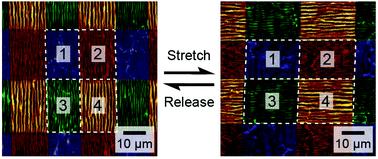Our official English website, www.x-mol.net, welcomes your
feedback! (Note: you will need to create a separate account there.)
Soft skin layers for reconfigurable and programmable nanowrinkles
Nanoscale ( IF 5.8 ) Pub Date : 2020-11-26 , DOI: 10.1039/d0nr07054h Dongjoon Rhee 1, 2, 3, 4 , Shikai Deng 2, 3, 4, 5 , Teri W. Odom 1, 2, 3, 4, 5
Nanoscale ( IF 5.8 ) Pub Date : 2020-11-26 , DOI: 10.1039/d0nr07054h Dongjoon Rhee 1, 2, 3, 4 , Shikai Deng 2, 3, 4, 5 , Teri W. Odom 1, 2, 3, 4, 5
Affiliation

|
Wrinkling skin layers on pre-strained polymer sheets has drawn significant interest as a method to create reconfigurable surface patterns. Compared to widely studied metal or silica films, softer polymer skins are more tolerant to crack formation when the surface topography is tuned under applied strain. This Mini-review discusses recent progress in mechano-responsive wrinkles based on polymer skin materials. Control over the skin thickness with nanometer accuracy allows for tuning of the wrinkle wavelength and orientation over length scales from nanometer to micrometer regimes. Furthermore, soft skin layers enable texturing of two-dimensional electronic materials with programmable feature sizes and structural hierarchy because of the conformal adhesion to the substrates. Soft skin systems open prospects to tailor a range of surface properties via external stimuli important for applications such as smart windows, microfluidics, and nanoelectronics.
中文翻译:

柔软的皮肤层,可重整和可编程的纳米皱纹
作为产生可重构表面图案的方法,在预应变的聚合物片材上起皱的表皮层引起了极大的兴趣。与广泛研究的金属或二氧化硅薄膜相比,当在施加应变的情况下调整表面形貌时,较软的聚合物蒙皮更能耐受裂纹的形成。这份小型评论讨论了基于聚合物皮肤材料的机械响应性皱纹的最新进展。以纳米精度控制皮肤厚度允许在从纳米到微米范围的长度尺度上调节皱纹波长和方向。此外,由于对基底的保形粘附,柔软的表层使具有可编程特征尺寸和结构层次的二维电子材料能够纹理化。柔软的皮肤系统为定制各种表面性能开辟了前景通过对智能窗户,微流体技术和纳米电子学等应用很重要的外部刺激。
更新日期:2020-11-27
中文翻译:

柔软的皮肤层,可重整和可编程的纳米皱纹
作为产生可重构表面图案的方法,在预应变的聚合物片材上起皱的表皮层引起了极大的兴趣。与广泛研究的金属或二氧化硅薄膜相比,当在施加应变的情况下调整表面形貌时,较软的聚合物蒙皮更能耐受裂纹的形成。这份小型评论讨论了基于聚合物皮肤材料的机械响应性皱纹的最新进展。以纳米精度控制皮肤厚度允许在从纳米到微米范围的长度尺度上调节皱纹波长和方向。此外,由于对基底的保形粘附,柔软的表层使具有可编程特征尺寸和结构层次的二维电子材料能够纹理化。柔软的皮肤系统为定制各种表面性能开辟了前景通过对智能窗户,微流体技术和纳米电子学等应用很重要的外部刺激。











































 京公网安备 11010802027423号
京公网安备 11010802027423号